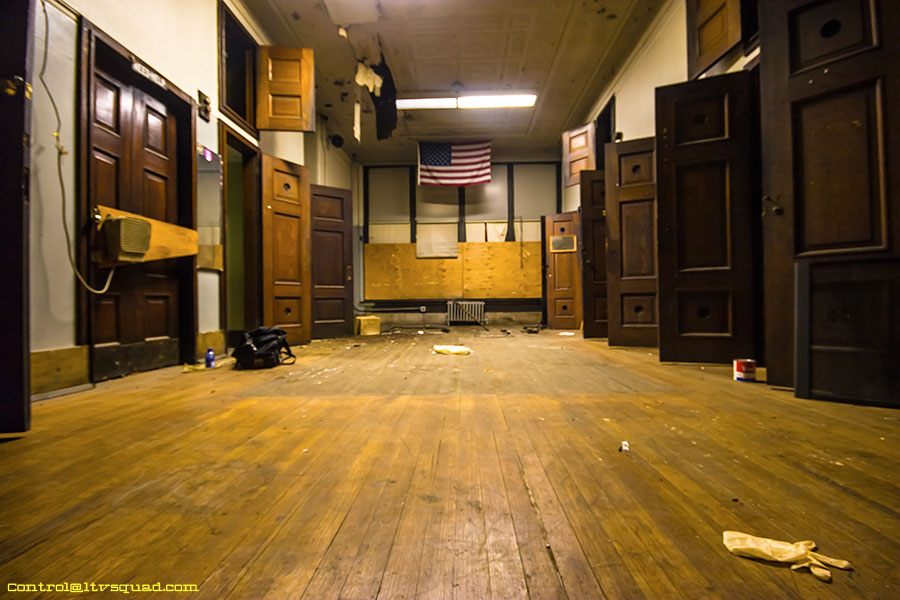
The abandoned FDNY Engine 212 firehouse in 2006.
Over the last 10 years, Long Island City (LIC), Williamsburg and Greenpoint transformed from neglected low-population industrial neighborhoods to tightly packed thriving residential areas. Dozens of factories and warehouses have been replaced with high rise apartment buildings. Basic NYC government services have not kept pace with the growing population, and one of the most overlooked and life threatening of those services is the NYC fire department.
In 2003, former Mayor Bloomberg closed 7 firehouses in NYC. Two of those were located in Williamsburg (engine 212) and LIC (engine 261). 2 years after closing these fire houses, Bloomberg rezoned much of North Brooklyn for high rise development (LIC was already rezoned in 2001). Less services + large population density. What could go possibly wrong?
In the case of Engine 261, response time to fires in the area immediately went up. Some area residents didn’t even know they were losing a firetruck: The community board covering Roosevelt Island was not properly notified.
The same increase in response time has affected Northwest Brooklyn, where response time increased up to a minute. A minute is a long time when a building is on fire. A minute is often the difference between life and death. Just check out the videos from the recent gas explosion on the Lower East Side, where an off-duty fireman helped rescue a woman from a fire escape and took a quick look for additional victims. By the time he got back to the ground, the building is fully engulfed. If there had been additional victims trapped upstairs, they would not have made it. All of this happened before the first truck due arrived!

New residential towers rising above old industrial buildings

Buildings like The Linc (left) have brought thousands of new residents to an area previously full of old warehouses, and thousands more are on the way.
Today, the Williamsburg waterfront has gone from a desolate playground for punks (anyone else remember The Beer Olympics?), graffiti artists and drug addicts, to a completely residential, high-end neighborhood. The former BEDT terminal is now all residential. The LIC waterfront is filled with dozens of new high-rise apartment buildings and hotels, typically 40 floors in height. The Court Square area is seeing a surge in ‘development’ with the conversion of the old Eagle Electric factory into apartments, the new ‘linc’ high-rise (which took the place of a small tenement building) a CUNY law school, and several new high rises in the works. The former 5 points will be residential towers, along with the old CN West factory. The LIC economic development partnership brands LIC as one of the fastest growing neighborhoods in NYC. So does the Wall Street Journal. Even the cities’ own out-of-date-data shows this growth.. The proof is also in the huge increases in subway ridership to L.I.C. subway stations.

New high rises along Kent Avenue where only industry existed before (previously the site of the former BEDT Railroad Terminal)
“Since 2006, approximately 6,400 rental apartments were created in Long Island City compared to just 2,200 finished condominiums, according to numbers compiled by neighborhood business group LIC Partnership.” That’s approximately 8800 apartments. If each apartment has 2 residents, that’s a population increase of 16,000 – with zero increases in first responders. (Of note, there doesn’t seem to be an exact, up to date formula for recommended number of firefighters vs. population in urban areas, though a number of 1:1000 or 2:2000 seems common – by that measure LIC is well below where it should be in terms of proper fire staffing).
Roosevelt Island relies on a ‘special operations’ firehouse, along with engine 260 and ladder 116 just across the river in LIC (Engine 261 was located with Ladder 116 until it was closed by Bloomberg). In the event of a major fire, the first wave of fire response would largely come from LIC & Astoria. With Engine 261 closed, the next closest engine would be 262, followed by 263, 312 or 258, which are all much further away. A full muster 1 alarm response (around 10 trucks & associated personnel) could take at least 15 minutes to arrive.
The formerly Abandoned Octagon, in 2001 and in 2014
In 2017, Cornell University is set to open a graduate technology campus on the southern end of the island. This campus will have housing for 2000 students and 280 staff. That’s over 1500 more people on the island than the former population of Goldwater hospital. And this is just the first phase of the project. The second phase isn’t set to be completed until 2037 and includes several new buildings. In the last 10 years, development across Roosevelt Island has spread. Riverwalk #7 will open this year (part of a completely new complex that took over where the old nurses residence was). The abandoned ‘Octagon’ is now an apartment building. There has been a very significant increase in Roosevelt Island population over the last 10 years, with a documented decrease in fire protection.
There has been a significant increase in Roosevelt island population over the last 10 years, with a documented decrease in fire protection.
Not so coincidentally, city government has also failed to plan for enough schools to address the growing population. In LIC, students have been wait-listed. The same thing is happening in other neighborhoods as well. I mention this because it shows a very clear lack of planning on behalf of the NYC City Council and Mayors (both past and present). One could (easily) argue that elected officials have given real estate developers a blank check to build as they please without any thought going into how livable or sustainable these completely redeveloped neighborhoods will be. The same can be said for transit, where subway ridership is at an all time high and there’s no money to add capacity.
LIC, Williamsburg and Greenpoint look more and more like Manhattan every year, except when it comes to city services. All you need to do is look at a map of firehouses in Manhattan compared to In Queens and Brooklyn.

Here are Manhattan’s Firehouses
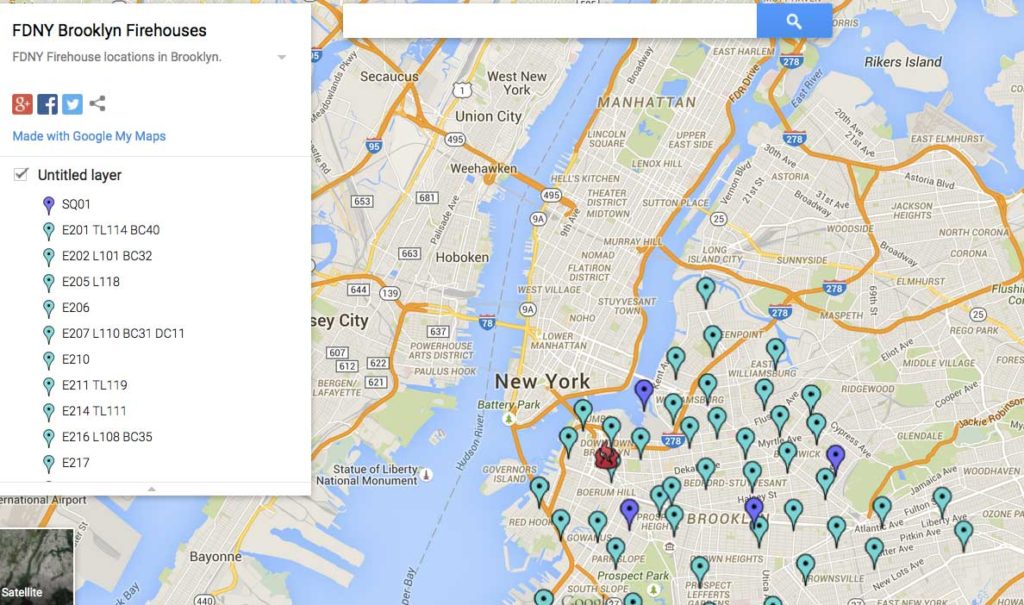
North Brooklyn’s Firehouses – a little less dense than Manhattan
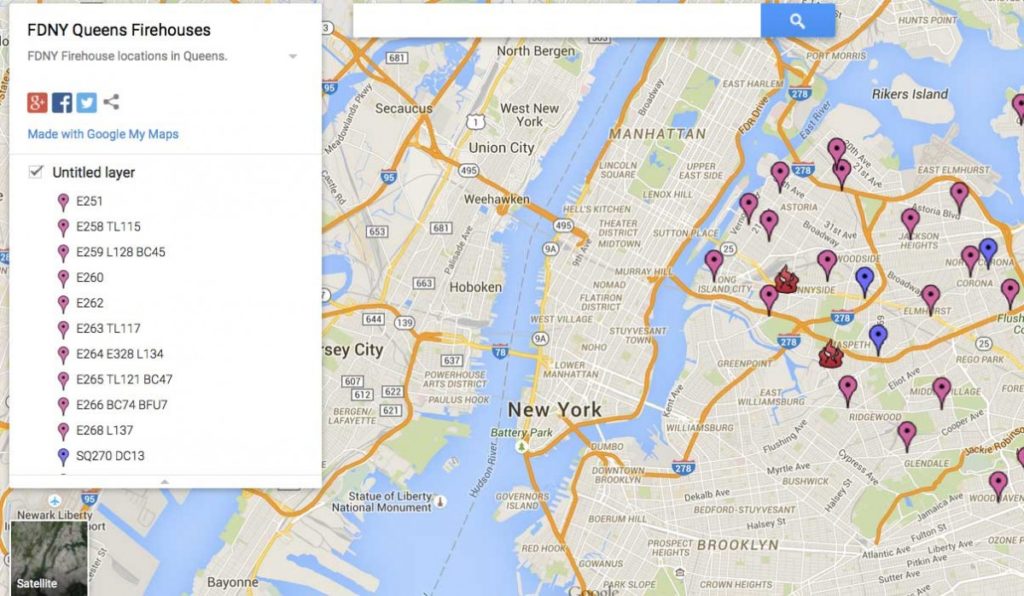
And finally we have Queens, with firehouses even more spread out.
Simply stated – there’s a higher density of firehouses in Manhattan compared to neighborhoods in Brooklyn and Queens that have been rezoned for high rises buildings. These ‘outer boro’ neighborhoods will soon have the same population density as Manhattan without the services to match.
FDNY personnel is spread thin in these neighborhoods, and many of the new residents of these neighborhoods are new to the area (or new to the city), don’t know that their fire houses were taken away, or that they are being short changed on services. The only reason they don’t know is because there haven’t been any articles written on this subject at all, and no stories in the press or even on other blogs.
The largest fire in NYC post 9/11 took place in Greenpoint. Engine 212 would have been one of the first on the scene. This fire burned for several days. On January 31st 2015, a large storage warehouse burned to the ground. Again, the fire burned for several days. Engine 212 was located a mere 4 blocks from where this fire took place. Would a faster, stronger response have helped prevent these fires from spreading out of control? It is by luck that neither took place in a residential building or involved fatalities.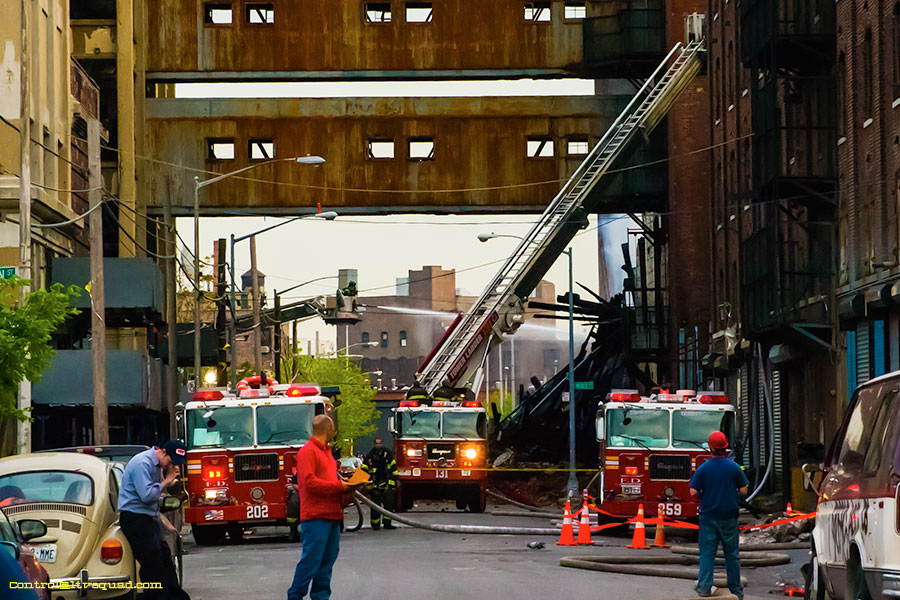
Greenpoint Terminal Burning in 2006
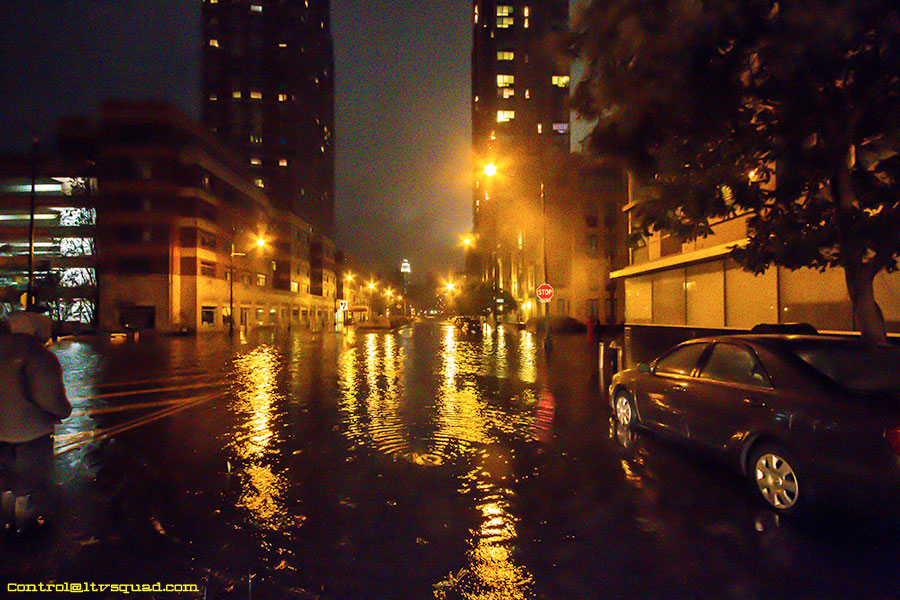
When Hurricane Sandy flooded the LIC waterfront, FDNY was very much spread thin. Dozens of sidewalk electric vaults were steaming overnight (threatening to explode). Fortunately no major fires broke out at the time (there was a major fire [likely storm damage related] at Wheelspur yard a month later) With Rockaway burning, fire trucks from LIC were seen all the way on the other side of Queens that morning – despite all the steaming faulty transformer vaults that could have caused plenty of electrical fires right in L.I.C.

Here we see FDNY Ladder 115 and Engine 260 with Con Ed checking buildings at the same spot 8 hours later.
Had any of these vaults exploded, they would have set cars and buildings on fire. In 2004 a transformer vault blew up on 23rd Ave and 31st street in Astoria – setting the building next it on fire.

Above we see FDNY Engine 258 (on the left) – the only engine truck assigned to ‘downtown’ LIC – in Rockaway the morning after Hurricane Sandy assisting on one of many major fires on Rockaway that night/morning (this was the fire that burned down the row of storefronts on Rockaway Beach Blvd between B113 and B115th streets – note the bus route sign for proof of location).

One of at least 3 major Sandy-related fires on Rockaway that morning
With climate change screwing with NYC’s weather more and more each year, it would be to NYC’s benefit to properly prepare. As Governor Cuomo himself stated: “Extreme weather is the new normal”. More fire protection would be a vital step in that direction. Many of the new high rises in L.I.C. are in a “Zone A” flood zone which was partially under water during Sandy. There was limited emergency personnel present, and residents were basically left to fend for themselves. For the amount of rent people pay to live in these areas, the lack of first responder/government presence on these streets is downright disturbing (We personally did not witness ANY first responders while driving through the area that night – no police or fire department personnel at all). It is only by luck that there were no major fires in the area that night. While there’s no way to protect against everything, relying on luck along isn’t a sustainable strategy.
***Note – this is not meant to ding FDNY command on the usage of assets during the worst night modern NYC has seen in decades. Rockaway was burning and needed all the help it could get – which included FDNY trucks from across the city and rescue crews from as far away as upstate and Maryland. During major fire events it is smart and routine for FDNY to relocate crews to provide coverage and keep crews fresh. This is a call for reopened fire houses, which would benefit NYC on a whole – not just LIC, Greenpoint and Williamsburg. No one with half a brain would say NYC couldn’t have used every engine from every firehouse Bloomberg closed during and after the storm. ***
Significant portions of NYC are in flood zones, and as we so vividly saw on Rockaway, Storm surges and utility lines combine to short out wires and start massive fires.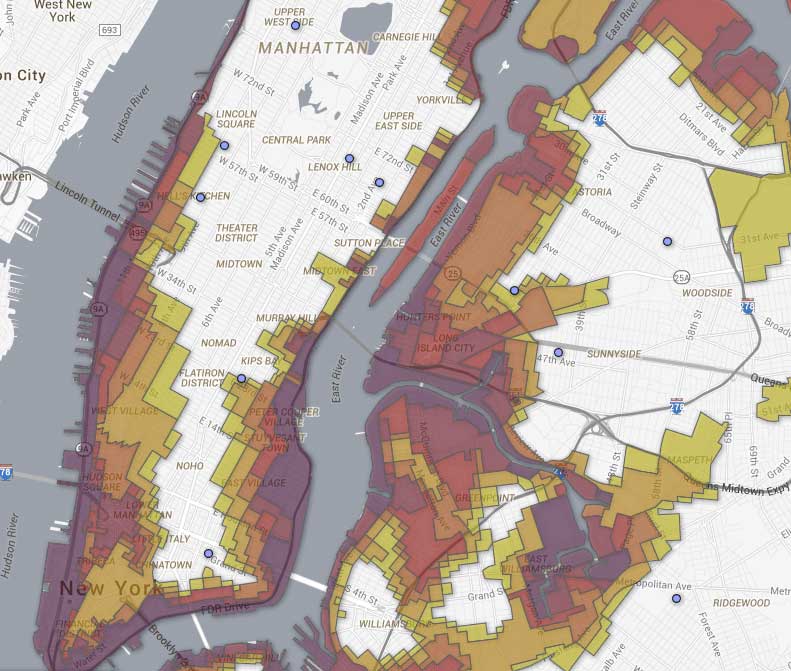
NYC Flood Zones (via http://www.floodzonenyc.com)
Unlike Manhattan’s 4 and 5 lane avenues, the streets of LIC and North Brooklyn are all very narrow – with 2 lanes of traffic at best.
With all of this ‘development’, traffic in the affected neighborhoods has grown at all hours of the day and night. Queens Plaza, Queens Blvd, Jackson avenue, Van Dam street – these streets can become virtual walls of traffic during rush hours, leaving LIC blocked from “reinforcements”. Unlike Manhattan’s 4 and 5 lane avenues, the streets of LIC and North Brooklyn are all very narrow – with 2 lanes of traffic at best. Much of Jackson avenue was made into a single lane roadway, while other streets in the area are still paved with cobblestone and practically unfit for travel. Poorly timed traffic lights add even more congestion by not keeping traffic fluid. Kent avenue in Brooklyn is in the same boat: This once sleepy 2 way street on the edge of nowhere has been transformed and lined with new high rises and parks. It is now a one lane, one way street clogged with cars, bicycles and foot traffic – a far cry from the deserted road that existed when Engine 212 was closed in 2003.
While the first trucks due might arrive quickly, back up could be a long way away due to traffic. That lack of backup means the first responders are putting their necks out even further, without any immediate help should the situation rapidly escalate.

A few LIC streets, like 43rd Ave, have probably never been paved (this one was last paved when David Dinkins was mayor according to the DOT). You can’t drive more than 3 or 4 mph on this… not good for first responders in a hurry.
Both LIC and Greenpoint/Williamsurg rely on the Pulaski and Greenpoint Avenue bridges when there is a fire on one side of the creek or the other. Both of these bridges are drawbridges, which are occasionally opened to boat traffic both during the day and at night. Should a bridge be opened and a fire breaks out, response time and lives will absolutely be on the line, as fire trucks from further into each boro or Manhattan would need to travel further to the scene. (It takes a good 10 minutes to open and close these drawbridges).
They can’t say there is no money to reopen these fire houses when they’re debating 1000 new cops.
Currently, the NYC City Council and Mayor are hashing out a new budget for next year. There is a debate on whether or not the city should hire 1000 new police officers, despite continued drops in crime for several years now. Also, 1000 new officers spread across 76 police precincts isn’t a significant increase. Why not hire just 50 firefighters and reopen Engines 261 and 212? They can’t say there is no money to reopen these fire houses when they’re debating 1000 new cops. Have our elected officials just plain forgotten FDNY exists? Why are we putting civilian and firefighter lives in danger by not maintaining ‘new’ firehouses and proper staffing to match the growth of rezoned neighborhoods? (*note – police & fire protection are both important)
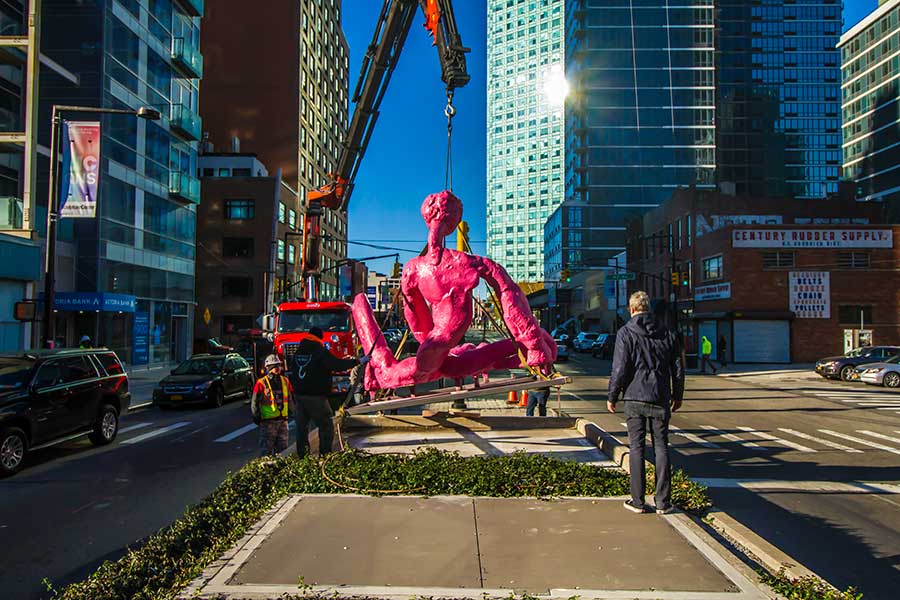
Instead of reopening firehouses, the city government wanted to give LIC a half million dollar sculpture. One critic summed up the proposed artwork nicely: “this looks like you dug up Gumby’s grandmother and threw it on the median” . This art project places the lack of priorities with out city government in stark relief. Half a million dollars could go along way towards reopening a firehouse. Instead they give us used bubblegum and call it art. When people die due to a lack of fire protection, I’m sure their families will be happy to know the money was spent on bubble gum instead.
Let’s do some very basic math (it’s a little more complex, but let’s keep it simple): 5 firefighters per engine, 3 crews for 24/7 coverage. Top salary is $99k (after 5 years) – so we’re at around $1.5 Million. Truck, fuel, etc adds up some cost too. So let’s say $2.5 Million per engine. NYC’s budget is $70 Billion dollars. The cost isn’t nothing, but it’s certainly not impossible – and NYC is growing. Top pay for NYPD is $90k after 5 years, and with 1000 officers that’s a cost of $100 million. Why not hire 500 police officers and reopen all 7 closed firehouses? To reopen all 7 firehouses closed under bloomberg would cost around $21-$25 Million. What is the justification for keeping them closed? To sustain the growth that NYC is experiencing, we need to add the services to match.
I sometimes liken NYC today to a pyramid scheme – where real estate owners are trying to cram as many high rises and residents into the city as they can, before the lack of services (schools and transit have been in the news a lot lately) renders the city into an unlivable cesspool of angry humanity. How are all of these new huge buildings being built all over NYC and there’s somehow not enough money to fix the broken city services? The answer is at least in part due to a huge tax loophole.
421-a is a tax giveaway for real estate developers. See all those new tall buildings in these neighborhoods? Many of them are paying no taxes to the city. No taxes = no money for services. To put it more bluntly: 421-a = No money to fund first responders, transit options and schools.
421-a is a tax giveaway for real estate developers
There’s a lot more to 421-a of course. You can read a whole lot about it here, though this quote sums it up nice: “…the program is now costing New York City over $300 million per year. In some cases, we are giving multi-million dollar tax breaks to exclusively luxury development in lower Manhattan and downtown Brooklyn, developed by some of NYC’s biggest developers.
$300 million a year? That sounds like an estimate of the amount of money we need for additional firehouses, schools and transit. (According to the Independent budget office – the number is closer to $3 billion since 2012 – $3 Billion Dollars!). Regardless of who you ask – the answer is simple: the amount would be enough to fund services and then some.
421-a expires on June 15. Some say the loophole needs to be severely modified. I’m on the side of those who say NO. Let 421-a expire or be replaced with something realistic. THIS SHOULD NOT BE UP FOR DEBATE. If you are for 421-a, you are against first responders, schools, and transit. Period. Once 421-a expires, all buildings set to receive this abatement for years into the future should be forced to pay their taxes starting in July. That would be the fair thing to do. It would be the smart thing to do. Unfortunately, NYC and NY State leadership is failing to represent their constituents. Why is that?
Governor Cuomo and Mayor DeBlasio think 421-a should be kept. “Progressive” DeBlasio wants minor changes at best while Republican Cuomo (let’s call him what he is) wants no changes at all. The real estate industry is one of the biggest and most reliable donors in the campaigns of New York State politicians, which is the most politically corrupt in the United States. Cuomo is the last of the ‘three men in a room’ that run New York State politics who hasn’t been arrested – though speculation is growing that he may need a lawyer soon. Much of that corruption has links to the real estate industry. Let me make this clear: Any politician in favor of keeping 421-a is 100% against first responders, schools and transit.
Any politician in favor of keeping 421-a is 100% against first responders, schools and transit.
Some neighborhoods are starting to protest all of this over-development. If NYC is to remain a livable city, we’re going to need to see a lot more such protests (since protests seem to be the only thing that gets these politicians attention besides gobs of cash).
It is our position that reopening FDNY engines 212 and 261 would only be the start to increasing protection in the affected neighborhoods; it would be the ‘minimum viable product’ to enhance safety in these neighborhoods. (In the case of 261, the firehouse still exists with Ladder 116 utilizing the quarters. For 212, an entire new building would need to be built (unless the community center wants to give it back to the city – even then it would need some serious repairs). Realistically, neighborhoods on both sides of newtown creek probably need more fire protection. Doing a study to verify it might be worthwhile but studies do not equate into action. All neighborhoods that lost firehouses under Bloomberg should re-assess their unique situations. Even those who live far from the affected neighborhoods have a horse in this race (how many more homes on Rockaway would have burned if not for FDNY help coming from as far as the Bronx?). This is a local neighborhood issue with citywide impact.
It is our hope that by publishing this, a serious conversation is started. The government is clearly not providing the services it should. Instead, the government is giving real estate developers a huge tax loophole. Enough. Enough of the rich getting richer while average citizens have to fight over table scraps. It is long overdue that they pay their fair share, to make NYC an even better place to live.
In the long term, citzens in neighborhoods that are being looked at for rezoning (i.e., all of NYC) , need to start demanding more. If developers want to cover entire new neighborhoods in taller buildings and more residential density, maybe they should be paying higher taxes to do so (with no loopholes). For the money that real estate developers are making off of the gold mine that is NYC, replacing services that were taken from the people during lean times is absolutely not too much to ask – in fact it is the bare minimum.
If you agree with our position, please take a minute and contact your local elected representative. Re-blog this. Post it on your social media accounts. Talk about it with friends and neighbors. Contact the press, and ask them why they aren’t reporting on this.
Here’s a list of the elected officials representing in LIC, Greenpoint and Williamsburg, along with the Mayor’s contact info. Complaining is 100% free and the squeaky wheel gets the oil.
NYC Mayor’s contact Info:
http://www1.nyc.gov/office-of-the-mayor/contact-the-mayor.page
Mayor Bill de Blasio
City Hall
New York, NY 10007
PHONE
311 or 212-NEW-YORK outside NYC
LIC City Council Rep:Jimmy Van Bramer
District Office Address
47-01 Queens Boulevard Suite 205 Sunnyside, NY 11104
District Office Phone
718-383-9566
Email
JVanBramer@council.nyc.gov
Astoria:
Costa Constantinides
District Office Address
31-09 Newtown Avenue
Suite 209, Astoria NY 11102
District Office Phone
718-274-4500
LIC & Astoria State Rep:
MICHAEL GIANARIS
31-19 Newtown Avenue Suite 402
Astoria, NY 11102
United States
Phone: 718-728-0960
Fax: 718-728-0963
Greenpoint/Williamsburg City Council Rep:
Stephen Levin
District Office Address
410 Atlantic Avenue Brooklyn, NY 11217
District Office Phone
718-875-5200
State Representative:
Joseph R. Lentol
District Office
619 Lorimer Street
Brooklyn, NY 11211
718-383-7474
Williamsburg City Council Rep:
ANTONIO REYNOSO
244 Union Ave
Brooklyn NY 11211
District Office Phone
718-963-3141
areynoso@council.nyc.gov
Update: August 2019.
Absolutely nothing has been done about this issue. Our cowardly mayor & his cronies are hiding behind ‘amazon not coming to LIC’ as an excuse not to reopen engine 261.
A well written article I must say. However, One major thing you failed to mention. Greenpoint/Williamsburg is also in the process of adding another 9,000 units of housing accommodations ( be it an apartment, loft, etc….).Four of which will be high rise buildings. So that’s a minimum of 9,000 more people. If those occupancies are two, three or more bedrooms that’s another 9,000-27,000 added to the 9,000 people packed into an area that once housed two and three family homes that had at most three bedrooms per apartment. And with these additional housing units come the other calls for assistance that aren’t fire related calls. Medical, smoke and carbon monoxide detector activations, water leaks and the other assorted problems that people often call 9-1-1 for.
Firefighter salaries are the same as police officers due to parity. and the top pay for both is approximately $74,000 annually not including overtime and other . Also fire department shifts are arranged in two shifts per 24 hours, the day shift is 9 hours and the night shift is a 15 hour shift. Firefighters work a rotating schedule, meaning a few day shifts then a few nights shifts.
Gene – all good facts. The exact same thing is happening in the LIC side of the creek, and even all the way up the river in astoria (that new ‘astoria cove’ project and a high rise by rainey park). This lack of increased city services is only going to get worse if we all don’t start demanding them. These politicians all talk about adding a million people to NYC but they don’t talk at all about the schools, fire, police protection, etc.
Just wait until Hunters Point South is built. Maybe we’ll get a high rise fire with jumpers. Will the politicians will wake up then? – See this if you don’t know what I speak of: http://www.nycedc.com/project/hunters-point-south
“Up to 5,000 housing units, 60% of which will be affordable to low/moderate income families, are expected to be developed on the site.”
Assuming 2 people per apartment, that’s 10,000 new residents to come to a part of Long Island City that was under water during both Sandy and Irene! Excellent city planning! NOT!
Hear, hear, good article.
It took a few news articles before anyone in Detroit realized that we no longer had working high-tower apparatus in the DFD…the unfortunate byproduct of that however was that insurance adjusters were quicker to take notice than local politicians, and some businesses had a nasty surprise when their insurance rates suddenly went up.
LOL! Yeah it will take a long time but I bet when insurance starts going up the companies owning all this crap will start begging for more fire protection… while begging from their other hand to keep the tax loopholes causing the problem in the first place.
I couldn’t resist commenting. Well written!
Very well written I agree with you what needs to happen and I know it a long dream is to bring back work one getting the majority of the company that were closed from the 1970’s till 2003 reopened because there was a study done by a retired chief from fdny that said if he had more engines then what he had on 9-11 to the trade center we would be have been able to do more but with the closings of a lot of engines over the years from the 1970’s till 2003 fdny on 9-11 was maxed out to the point of the firefighters were getting stressed out by doing 5 to 6 things at once so I say because nyc contines to be a target for terrorists they should look at reopening not just engines 212 and 261 but reopen engine a lot of the manhattan companys that were closed like engine 13, 17, 27, 31 32 36 and rescue 6
I think I think its time reopen alot more than the fire houses bloomberg ordered cloosed in 2003 i think we should look reopening maybe atleast 15 companys that were closed over the last few decades a good source That i knew from year ago said that they could have done more when if they had the right amount of engines when the towers were hit in 1993 and then in 2001 if they had them they could have gotten alot more help to the people in the towers on 9-11-01 it is high time to beef up public safety let them have the equipement they deserve